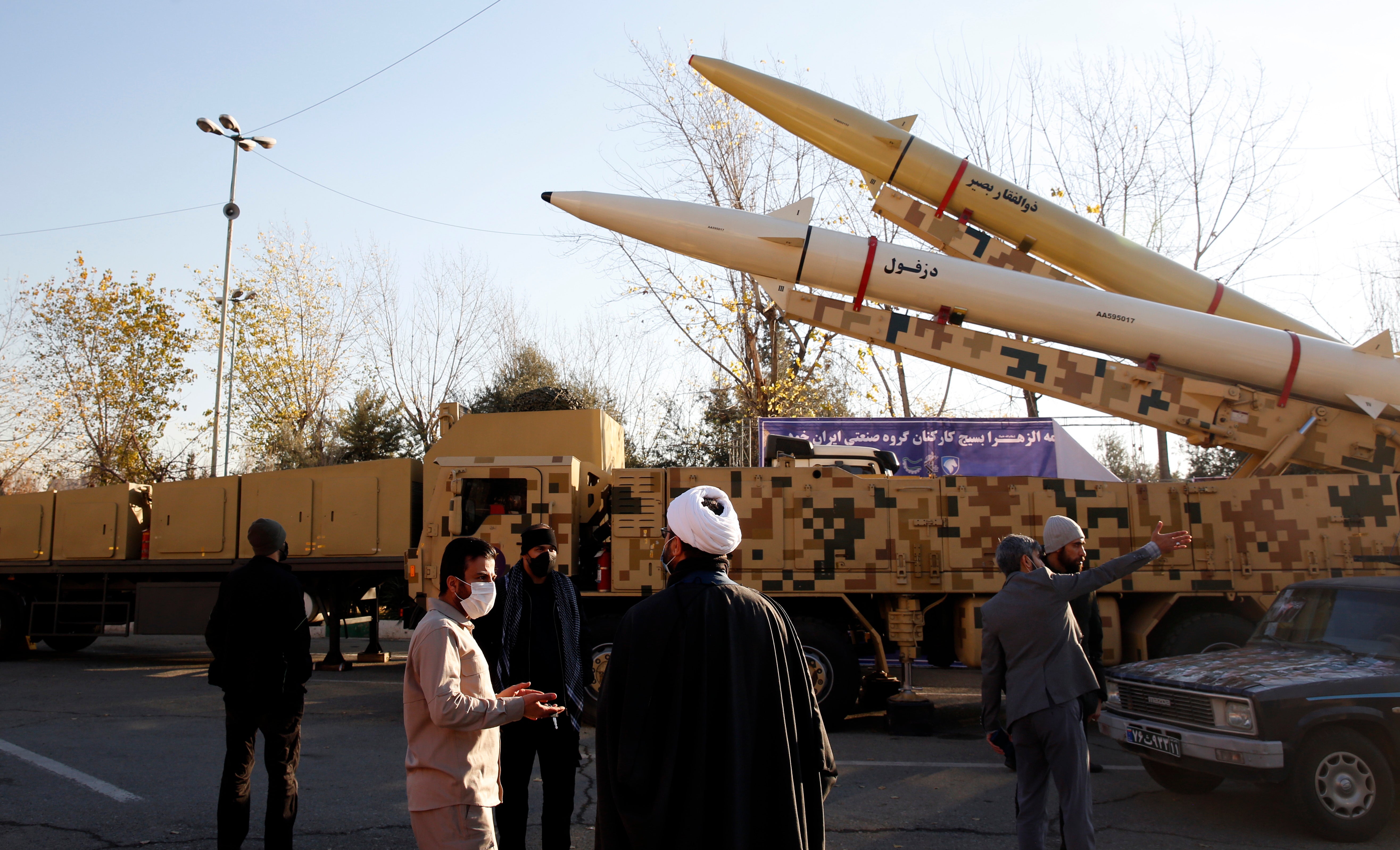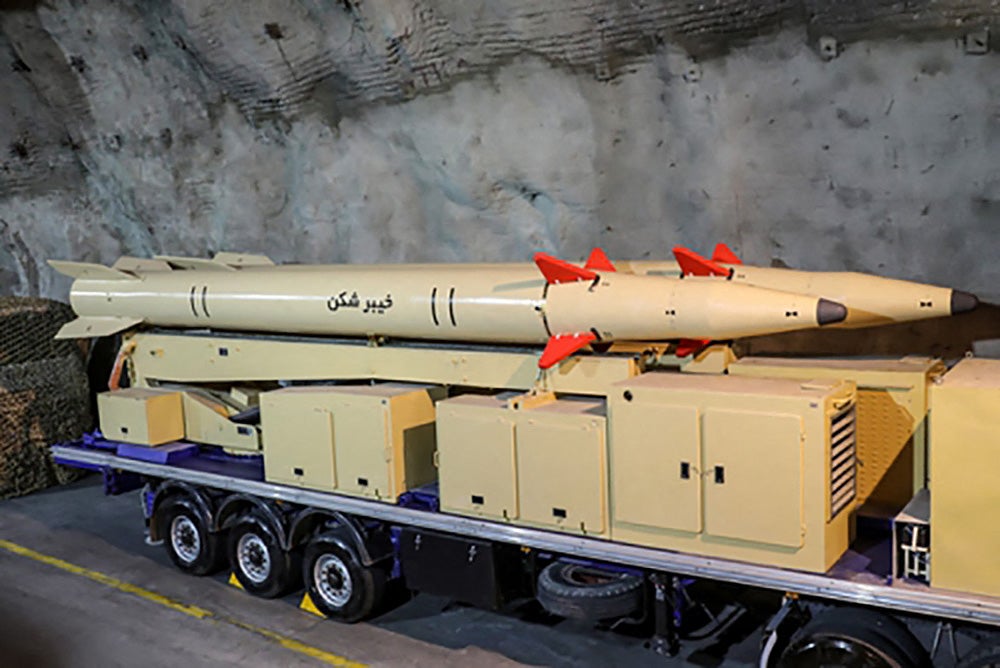Iran unveils new missile that puts Israel and US regional bases within range
Iranian state TV’s announcement comes amid the resumption of talks to salvage a 2015 nuclear deal

Your support helps us to tell the story
From reproductive rights to climate change to Big Tech, The Independent is on the ground when the story is developing. Whether it's investigating the financials of Elon Musk's pro-Trump PAC or producing our latest documentary, 'The A Word', which shines a light on the American women fighting for reproductive rights, we know how important it is to parse out the facts from the messaging.
At such a critical moment in US history, we need reporters on the ground. Your donation allows us to keep sending journalists to speak to both sides of the story.
The Independent is trusted by Americans across the entire political spectrum. And unlike many other quality news outlets, we choose not to lock Americans out of our reporting and analysis with paywalls. We believe quality journalism should be available to everyone, paid for by those who can afford it.
Your support makes all the difference.Iran has unveiled a new long-range missile that is capable of reaching its nemesis Israel. The weapon is named after a seventh-century battle that saw Muslim warriors overrun a Jewish castle in the early days of Islam.
On Wednesday morning, Iranian state television showed off the Khaybar Shekan, which is being described as a new, solid-fuelled, self-propelled, lightweight missile with a range of 1,450 km (900 miles) – more than enough to reach Israel from any point in western or central Iran.
The announcement came a day after negotiations resumed in Vienna to salvage Tehran’s tattered nuclear deal with the US and other world powers.
Iran has previously said its arsenal is capable of reaching Israel – to whom it issued a warning with missiles fired during military drills in December – as well as US bases in the region, one of which, in Iraq, it targeted two years ago.
If its declared specifications are accurate, the missile would represent something of a technical breakthrough. Up until now, Iran’s arsenal of long-range missiles capable of reaching Israel and the wider Middle East have been liquid-fuelled, meaning they are less mobile, more vulnerable to airstrikes, require a longer preparation time, and are generally less accurate.
“This one is a self-propelled missile that has the range of Israel,” said one international missile non-proliferation expert, who spoke on condition of anonymity because of the sensitivity of their work.
“It reduces the time you need for preparation; it reduces the amount of equipment needed. With a self-propelled missile you just press the button, and that’s it.”
The name of the missile, which is under the control of Iran’s Islamic Revolutionary Guard Corps (IRGC), refers to a 628 battle in which Khaybar, an oasis town on the Arabian peninsula, was besieged by Muslim forces until the Jews living there surrendered and agreed to pay tribute. Shekan means “breaker”.
“The enemies of the revolution and the Islamic Republic don’t pay attention to anything other than the language of strength and force,” IRGC commander Maj Gen Mohammad Bagheri said in a video montage posted online, which showed a missile being fired in the desert to a soundtrack of heavy-metal music.
Iranians have for days hinted that a major weapon would be unveiled this week, coinciding with celebrations to mark the anniversary of Iran’s 1979 revolution.

“The timing of unveiling the missile at the 43rd anniversary of the Iranian revolution is in one way a message to Iran’s adversaries,” said Syed Ali Abbas, co-founder and managing editor of Global Defense Insight, an Islamabad-based military news outlet.
“It shows Iran has come a long way in its indigenous missile program,” he told The Independent.
The provocative theatrics come just as a fresh round of talks over Iran’s nuclear programme gets under way. It has been hinted that they are making progress.
World powers including the United States, United Kingdom, France, Germany, Russia and China are in discussions with Iran over a formula to resurrect the 2015 Joint Comprehensive Plan of Action (JCPOA).
That agreement placed strict limits on Iran’s nuclear technology programme in exchange for a lifting of US and international sanctions.
It was sabotaged by Washington under the administration of Donald Trump, who escalated economic sanctions on Iran with the aim of pressuring it into a deal that would also encompass its missile programme.
Instead, Iran dramatically expanded both its nuclear and missile programmes. Over the years, Iran has insisted that any discussion of its conventional missile arsenal – which is among the largest and most diverse in the world – is off the table.

“While this will definitely raise tension in the region, it is also a sign for negotiating parties in Vienna that when Iran says the ballistic missile programme is non-negotiable, it is serious in its words and actions,” said Mr Abbas.
In reports promulgated by state and state-backed media, Iranian military officials claimed the missile had “pinpoint” accuracy.
Mr Abbas said it was too early to draw technical observations about the missile. But the range claimed by Iranian officials falls well within the country’s proven abilities. Iran has previously launched airstrikes against Isis positions in Syria, and, in January 2020, against an American base in western Iraq.
The video showed the missiles in a storage tunnel, suggesting they are already operational. Their short size means they are easily transportable, and could potentially be supplied to Iran’s proxy allies, such as Hezbollah in Lebanon, the Houthi militia in Yemen, and various militias in Iraq.
Working mostly from North Korean designs, Iran has relentlessly sought to expand its missile programme since its 1980s war with Iraq, when major urban centres were bombarded by Iraqi fighter jets and rockets during what was described at the time as the “War of the Cities”.
Tensions between Israel and Iran have spiked in recent months, though neither country has ever launched a direct attack on the other.
The Israel air force last month reportedly ran a war drill involving dozens of planes over the Mediterranean Sea, in what was described as a simulation of a large-scale attack on Iran.



Join our commenting forum
Join thought-provoking conversations, follow other Independent readers and see their replies
Comments